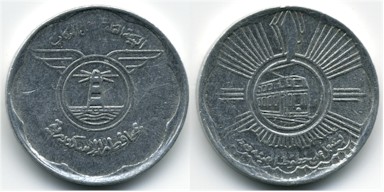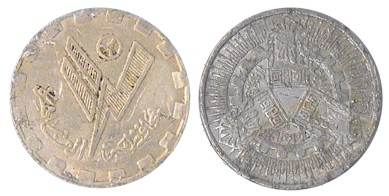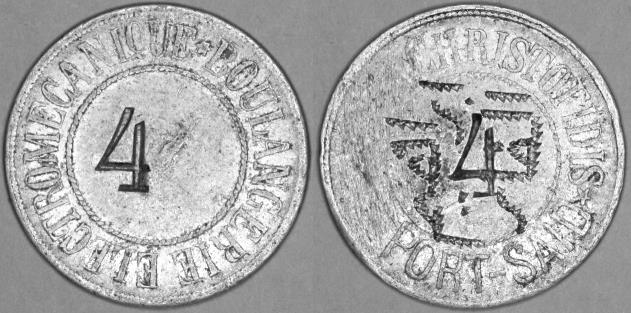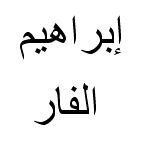EGYPT (2 of 4)
Two things....
Modern Transport Tokens
A Token from Port-Said
See more at... Egypt - Page 1 of 4 , Egypt - Page 3 of 4 and Egypt - Page 4 of 4
These are two similarly sized Aluminium tokens from Egypt.

A transport token from Alexandria. Scale is 200dpi,
(image
from Kenji Natsume)
I am told that this one is a tramway token from the city of Alexandria.
There are a small few world coins with lighthouses on them,
some of them can be seen here..... http://www.lighthousestampsociety.org/money/

A transport token believed to be from Cairo, scaled to
approximately 200dpi,
This second Egyptian transport token is one I have had for more than
10 years.
For a number a years I had no idea of what it was - not even the
country
of origin..
The design seems to incldue the date "1980" (centrally three times)
but I am not sure.
Most old tokens of Egypt seem to be from
Cairo, otherwise Alexandria - so being from Port-Said makes this piece
a little different. Port-Said is a city on the Mediterranean coast, on
the northern end of the Suez Canal; it is one of Egypt's larger cities,
though on nothing like the scale of Alexandria or Cairo. Here is the
token:-

A token for an "Electromecanique Boulangerie" in Port-Said - actual diameter about 28.5mm
I have shown the cleaner side of the token
first, perhaps this would actually be classed as the reverse side; also
I have shown the stamped "4" as upright on each side of the token -
just to make that particular feature clearer. Taking a look at the
token we have...
First side...
The legend is “BOULANGERIE ELECTROMECANIQUE” right-around, with one
six-pointed star spacer at the 6 o'clock position and then with a “4”
stamped in the otherwise blank central circular area
Second side...
The legend is - firstly the word “CHRISTOFIDIS” (above-around) and
before it a short obliterated section of legend, perhaps the first name
of a Mr Christofidis had been shown here. The further legend reads
“PORT-SAID” (below-around) with a five-pointed star separator after
this place name and likely a five-pointed star has been obliterated
from just before this place name and then there is a “4” stamped in the
central circular area. Not only has some of the legend been obliterated
from this side of the token, but also an additional Arabic legend has
been hand engraved over the central area on this side. To read this
part of the legend look at the token so that you are reading the "S" at
the end of the word “CHRISTOFIDIS” upside down. Two lines of Arabic
text should now be apparent as follows...

The Arabic text as engraved on the token.
The top line of the engraved Arabic text
reads "Ibrahim" and the lower line reads "al-Far".
"Boulangerie Electromecanique" - this is a French term, literally, an
electro-mechanical bakery - in reality a place to go and eat where the
food came from vending machines. In German "Automatenbuffet" was the
word - a few such tokens, from perhaps as far back as 100 year ago,
from Vienna, Austria can be seen at
http://www.worldofcoins.eu/forum/index.php/topic,12271.0.html
and http://www.numismatik-cafe.at/viewtopic.php?f=22&t=3975
The obliteration of a name (or just a first name) before "CHRISTOFIDIS"
and the addition of the name "Ibrahim al-Far" could perhaps relate to a
change of ownership of the shop from Greeks to Egyptians. Many Greeks,
British and French left Egypt around the time of the Egyptian
revolution of 1952. The first ten or so years of the 20th century would
have been a bit early for the use of Aluminium for a token. So my only
suggestion for when this token saw use would be the late 1940s to the
1950s.
Finally as mentioned - there is a large "4" stamped on each side of the
token - what could this be for? Thinking of smaller, slightly earlier,
British machine tokens for other types of vending, some general types
of these are known to have a low number e.g. 1, 2, 3 or 4 stamped on
them in a central circular area. Sometimes this is on tokens that
already show a denomination, so it would seem that these stamped
numbers were not used to indicate a value, but instead functioned as
some sort of control. Perhaps these tokens were grouped according to
the stamped numbers, with each group of tokens being for a slightly
different use, or perhaps the owner had several "Boulangerie
Electromecanique" establishments each using a different group of the
tokens. I would imagine that all of the machines would have had to have
been operated with tokens and that those tokens would have been sold to
the customers, perhaps with discount for buying in quantity and/or in
advance. I have not seen any other Egyptian tokens for this type of use.
See more at... Egypt - Page 1 of 4 , Egypt - Page 3 of 4 and Egypt - Page 4 of 4